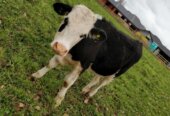How does a train enthusiast get their steam engine fix once they have been phased out?
They build their own.
That’s exactly what Cambridge Model Engineering Society member Dennis Searle did.

It took Dennis Searle six and a half years to machine his WAB 801 model steam locomotive. Photo: Benjamin Wilson
Searle’s love of steam engines started early on account of his grandfather, who drove steam locomotives. Searle had aspirations of driving them too, but as he was leaving school, steam trains were beginning to be phased out in favour of diesel-electrics.
So, he chose to join the air force instead of becoming a train driver.
“The only way I could drive a steam loco was to build one myself,” he said.
The 78-year-old has since built two steam locomotive models, and except for the boilers which require a certification to weld, he machined the entirety of the models himself.
“It was for the love of it really,” he said.
The latest was finished in 2009 and is a coal-powered scale model of a WAB 801, which took him six and a half years to complete. It was on display at the Cambridge Model Engineering Society’s Matariki event last Friday.

Photo: Benjamin Wilson
Although they are based in Cambridge, the club is essentially Waikato wide and is helmed by Kihikihi man Bruce Casey, who is the club’s president. Menzshed spokesperson Steve Mannington, also from Kihikihi, is a member too, and Searle himself is from Hamilton.
The club has two of their own diesel-electric model locomotives and use others that are owned privately by members. But Searle’s WAB 801 is the only steam powered locomotive they use.
The club has become less engineering focused and more family friendly, with its members ranging in age from five through to 84.
“It started out as an engineering club, making trains, fixing things and that sort of thing. Now the people coming through aren’t interested in that, so we just try to make it family friendly as much as we can,” said Casey.
They operate on the first and third Sundays of each month, providing train rides to the public on a track that is concreted into the Leamington Domain. Club members must hold a licence to drive the trains. Licensed children who are members of the club are allowed to drive the trains too – but without passengers.
Casey said the club is keen to get more volunteer members who can help with a variety of roles from clipping tickets, guiding the public onto the trains, to learning more about the trains and servicing them.
He said because of low volunteer numbers, if a few members don’t show up on one day, they might not be able to run.
“We are just trying to get a few more people involved.”









